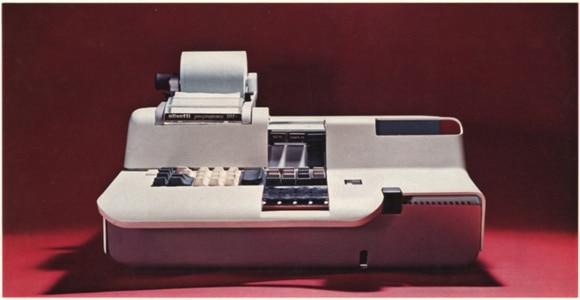
Almost 50 years ago, a small team at the Italian company Olivetti managed to do what no one had done before them; they created a computer small enough to fit on a desk, and could be used by regular people. It was the Programma 101, what many consider to be the world’s first personal computer.
To understand just how revolutionary the Programma 101 was when it was unveiled back in 1965, you first have to know what computers looked like at the time. Remember, this was almost 50 years ago. It was the era of huge mainframes, big as fridges, sometimes filling up entire rooms. Only a small elite had access to them.
People were used to seeing this:
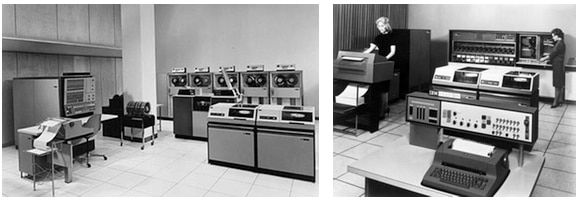
Above left you have the IBM System/360 Model 30, introduced in 1964, and to the right you have the IBM 1440 Data Processing System from 1962. These massive installations were what people associated with the word “computer”.
So imagine the impact when Olivetti presented this:
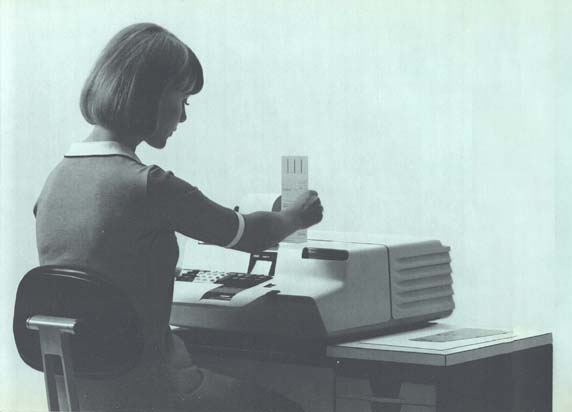
So how did that incredible paradigm shift happen?
1962, the idea of a personal computer is born
In the early 1960s, computers were not something you could have all to yourself, and most people didn’t even have access to them.
At the time, Olivetti was trying to compete with the American companies, making large mainframe computers. Being from Europe, they were a bit of an outsider, but they had some limited success.
But Roberto Olivetti, then-CEO of the company, wanted to try something truly revolutionary. He wanted Olivetti to make a small computer that was more affordable and could be used by regular people, something that you could place on a regular desk. He wanted to create a personal desktop computer.
He gave the project to Pier Giorgio Perotto, an engineer at Olivetti, who would work with a small team of just four people to try and get around all the technical hurdles and create this revolutionary device.
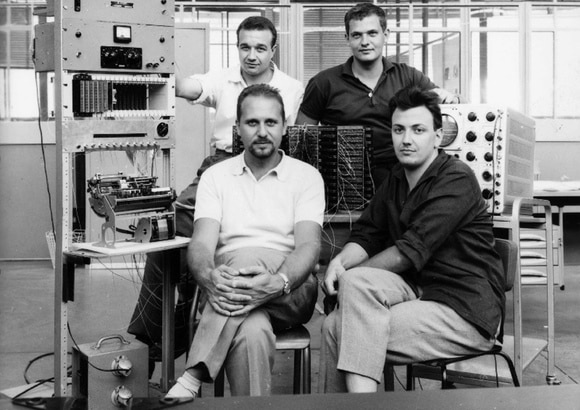
Above: Pier Giorgio Perotto (bottom left) and his small team (minus one).
The idea was insanely ambitious. Perotto’s team didn’t even know if it would be possible. The technology used in computers back then was way too bulky, so the team had to invent something new for almost every element of the new device, which was meant to be the size of a typewriter. The human-centric approach to designing a computer was also something completely new, and brought its own set of challenges as well.
The project started in 1962.
The challenge of making a PC in the 1960s
The first thing the team had to shrink was the memory. Memory modules in the early 1960s were huge. If Olivetti had used existing technology, the memory alone would have been as large as the entire computer they had envisioned.
So they had to create a memory module from scratch that was small enough for their purposes. Not an easy thing to do, but they came up with a kind of magnetostrictive delay line memory that was just a fraction of the size of other memory modules. It was roughly the size of a small motherboard in one of today’s PCs.
Next came storage. How would they store the programs? It had to be on something small and practical. The team came up with an ingenious solution, a card with two magnetic strips that could be inserted into the machine. Each card could hold one, sometimes two, programs that you could then start by pressing a button.

They had invented the programmable magnetic card. Thanks to this, anyone could enter a pre-made program into the device and run it in a few seconds. Its legacy lasted decades, including later evolutions of the idea such as the magnetic floppy disk.
Another challenge was ease of use. The way to program the computer had to be easy enough for a regular person, not a computer scientist, to learn and use.
The approach Perotto used was to create a simple programming language, something akin to a simplified assembler consisting of just a small set of instructions. The Programma 101 would later be shipped with a thin book that taught new users how to program the machine.
The actual physical design of the device was also a challenge. It was meant to be an elegant, human-centric and ergonomic device. Olivetti was famed for its attention to design (they made, for example, very beautiful typewriters), and the Programma 101 wouldn’t be an exception. The team involved Mario Bellini to style the device. It was a triumph of industrial design, very innovative for its time. Bellini would go on to become a world-renowned architecture and designer, so they really picked the right person for the job.
What they ended up with was a computer in a chassis that wasn’t much larger than a regular typewriter. It was easy to program, could store and run programs from a magnetic card and could be placed on a regular office desk. It weighed 35 kilograms, a featherweight at that point in time.
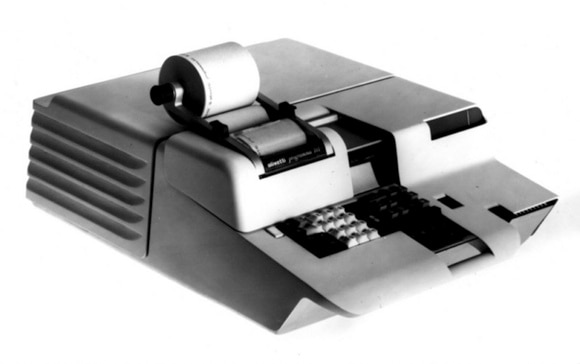
The Programma 101 was ready in April of 1964. The first personal computer had been built.
But there was a cloud at the horizon.
It almost didn’t happen
You’d think that the Programma 101 would have been a shoo-in, something Olivetti would have been eager to get behind. Not only that, it had the support of the CEO, Roberto Olivetti, who had spawned the initial idea.
However, in the spring of 1964 the company was in deep financial trouble. A crisis group was set in to restructure Olivetti, and part of their solution was to sell off the company’s electronics division. What did Europeans know about computers anyway? This was a disaster for the Programma 101 team, who were about to be thrown out of the company they loved.
Ultimately, General Electric rushed in and bought Olivetti’s electronics division early in 1965. Perotto’s team didn’t want their hard work to end up in American hands and maybe be cancelled forever, so they had a little trick up their collective sleave.
To avoid being swallowed up by GE, they changed the categorization of the project from “computer” to “calculator.” A tiny change, but it meant they were left under Olivetti’s umbrella. GE got the entire electronics division, minus the Programma 101 team.
Nevertheless, it was an awkward situation. Perotto’s team continued to work at the Italian facility, a building where GE now owned everything except their office. The team even painted the office windows so GE staff wouldn’t be able to see what they were working on.
Sadly, by now Roberto Olivetti had left his position as CEO, and the new management knew little about computers and clearly didn’t see the potential of this new invention. They were convinced there was no market for it.
If it weren’t for the New York World Fair in 1964-65, the Programma 101 would probably never have seen the light of day.
The 1964 New York World Fair

Like many other companies, Olivetti wanted to show off their newest products to the masses at the World Fair. The company was there to demonstrate their new mechanical calculator, the Logos 27. That was their focus.
The Programma 101, on the other hand, was hidden away in a small back room. The new management at Olivetti still didn’t believe in the project, and had it there as a prototype, an interesting oddity.
When the Programma 101 ultimately was unveiled to the masses at the world fair in October of 1965, it was the first time it was viewed by the general public. In an era when people largely regarded computers with suspicion, it had an impact few could have anticipated.
At the unveiling, the presenter from Olivetti explained to the audience that he would now calculate the orbit of a satellite, entered the card with the program, and ran it. It took a couple of seconds, then the computer started printing out the result. To us today this is hardly impressive, but 50 years ago it was en eye-opener.
The reception was overwhelming, the word spread, and soon it became clear that Olivetti had a huge hit on its hands. The Programma 101 was suddenly the front and center of attention at Olivetti’s booth. People were amazed at how something so small could be a fully working computer. Some even suspected it had cables connected to a larger computer hidden somewhere behind the scenes.
And the press loved it. You had articles in the Wall Street Journal and Business Week with titles like “’Desk-top’ Computer is Typewriter Size.”
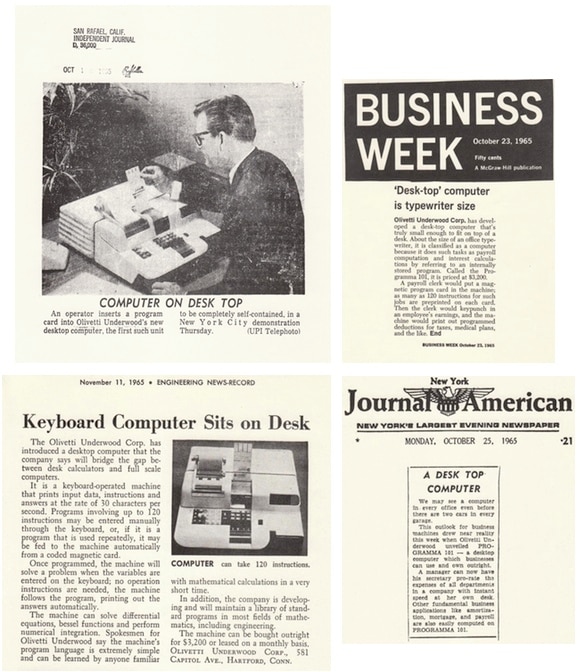
It was too much for the reticent management at Olivetti to ignore. Mass production started soon after, and the Programma 101 went on sale just a couple of months after it had been unveiled at the world fair.
Commercial success
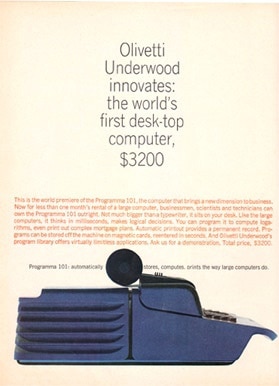 The price for a Programma 101 was around $3,200. Adjusted for inflation that is way north of $20,000 today.
The price for a Programma 101 was around $3,200. Adjusted for inflation that is way north of $20,000 today.
That may sound like a lot, but if you compare it with what a mainframe computer cost in the 1960s, it was a bargain. Even just renting access to a mainframe for a month would set you back as much as it cost to own a Programma 101. And actually buying a mainframe, even the cheapest available option, would cost at least $100,000.
Olivetti had created a new market, and was richly rewarded for it, selling around 40,000 units.
Since it was relatively affordable and portable, the Programma 101 gained widespread use. Even though at that price it could hardly be called a computer for everyone, it was still an enormous step in the right direction.
A fun aside is that NASA bought at least 10 Programma 101s and used them for the calculations for the 1969 Apollo 11 moon landing.
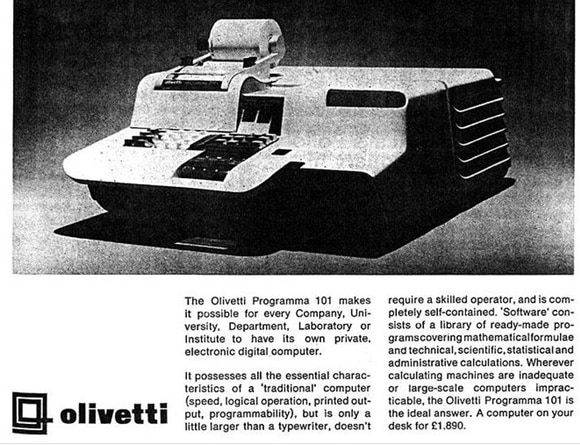
It wasn’t until HP launched its HP9100 series in 1968 that the Programma 101 got some real competition. Even then, it was a device heavily inspired by the Programma 101, and HP was ordered to pay Olivetti $900,000 in royalties for using such a similar architecture, and the famous magnetic card.
A few tech specs
By today’s standards, it’s not exactly a powerhouse, but remember this was 50 years ago, and the engineers were pushing the limits of what could be fit into such a small device.
- Weight: 35.5 kg (78 lbs)
- Power: 350 W
- Display: None. It used a small printer and a roll of paper 9 cm wide.
- Memory: Approximately 240 bytes.
- Storage: Magnetic cards. Programs could be split over multiple cards if they didn’t fit on one.
- CPU: None. This was before microprocessors, and integrated circuits had not really arrived on the scene yet. The logic was all made up of transistors, diodes, resistors and capacitors.
An amazing achievement
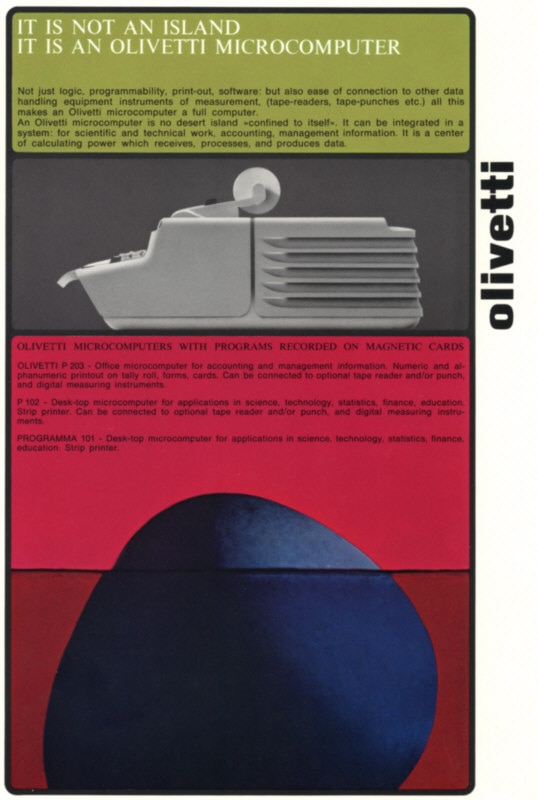
When you think about it, it’s simply amazing. A small team of just 4-5 people completely rethought the computing experience and ushered in the era of the personal computer.
We’ll leave you with a few snippets from the excellent documentary, Programma 101 – Memory of the Future:
To the Programma 101 team: We salute you!
Data sources: Primarily Wikipedia and the excellent documentary, “Programma 101, Memory of the Future.” There is also a bunch of interesting information at Francesco Bonomi’s Programma 101 site, if you want to really dive into the nitty-gritty of the device. Another great source was the site PierGiorgioPerotto.it, dedicated to the memory and achievements of this great engineer.
Image credits: Images courtesy of Francesco Bonomi (magnetic card and the sitting woman ad from his Programma 101 site); press clippings from the Pier Giorgio Perotto site (thanks to his son, Pierpaolo Perotto), StoriaOlivetti.com (Storia di un’impresa) for the device pics, ads and the photo of the P101 team; World Fair photo from PLCjr (via Wikipedia); IBM Archives for the mainframe pics; the UK P101 ad via Faktoider.nu.



























